The Gardener didn’t pay any attention as the Stranger exited the front door of the neighboring home. New to town, it was the only neighbor the Gardener hadn’t met. Other than the occasional person that mowed the long turf, rarely was there anyone outside. The postage stamp lots in the historic neighborhood were filled with mature trees and shrubbery, creating more privacy between the yards. The birds chirped and the squirrels were scurrying about. With dirt stained hands, the Gardener steadied the handle and forced the spade deep into the soil with the thickly-soled leather boot. There were ancient roots intertwined tightly throughout which would surely suffocate anything new planted there. The Gardener moved into the grey 1940’s two-story home five months ago, but this was the first time the weather cooperated along with time allowing the Gardener to get out and remove the old overgrown landscape. A month prior the overgrown mass was sprayed with herbicide, creating less curb appeal to the front of the house.

“Excuse me. Hello? Hello!”
The Gardener’s brain tuned into the faint voice of the Stranger who was walking toward the edge of the grassy property line. The Stranger was short with gray hair, polyester pants, an over sweater, and corrective shoes. The Gardener’s dog began to bark at the Stranger whose voice could hardly be heard.
“Quiet! Shhh! It’s okay. Sit.” The black dog obeyed sitting quietly while watching the Stranger step cautiously across the lawn toward the Gardener.
“Hi, I thought I should introduce myself to you since I am the one that sold you the house.”
“Hello! What a pleasure to meet you. I love the house. It has been so well taken care of.”
The Stranger pointed at the browning leafy landscape with an arthritic finger and bulging eyes. “Oh my! Did this all die or was it done intentionally?”
“Um. It was intentional.” Oh my God! How am I going to explain this? What a horrible landscape the front yard had. So overgrown and ugly. I had to kill it all.
Somewhat distracted, the Stranger pointed again with the same arthritic finger toward an arbor further back in the front yard. “What is that purple flower on that vine over there? It’s so big and beautiful! I have never seen anything like it.”
“It’s a Purple Hyacinth Bean. It’s really starting to show off right now with the cooler nights coming on. There’s nothing out there blooming like this right now. It’s not an edible bean though. Well, I guess you could eat it, but it is grown more for ornamental purposes. Would you like to take a closer look?” Why am I so polite? The last thing I need to do is walk closer to that side of the house where I cut down the tree. Too many people keep asking me why I cut down that tree. I don’t’ need to tell this person that I couldn’t stand the sight of it and how the flowers smelled like moth balls. The tree was probably planted ten years or more ago. Maybe this Stranger planted it and in a day I tore it down.
With arms crossed and a stern look, the Stranger boasted, “First tell me what you are going to do in the front. What is your big plan? ”
“Well, I am removing the groundcover, along with the few overgrown shrubs, and then I can plant a few boxwood at the front of the porch entrance, and a redbud tree, you know, with the small purple flowers that bloom along the stem in the spring, oh, um, and I think some annuals surrounding the bottom of the tree, like impatiens, oh! I found some impatiens tags in the planter box and thought to myself that must have been something that you used to plant there in the planter, which is cracking, so I was taking out a few bricks to repair it before it fell down, but then decided that since I have it almost all tore down, I won’t put it back up, so I will plant some flowering shrubs in its place under the window, and then a few annuals for color again here.” What is my plan? Gee whiz, I don’t know my plan other than having to kill everything so I can have a clean slate, then I can figure it out, I just need to stop rambling on and on to this person. Wait a minute, I know! “Since this is the front yard, I am going to create a more formal landscape! That is what I am doing.” The Gardener spoke out loudly as if to present the grandest landscape plan of them all.
“Ah. I see. I am not a gardener; my sister is the master gardener.” The Stranger stood with arms folded and a nodding head. “I had the dirt replaced twice in this garden because there was something wrong with it. I won’t tell you who brought me the first dirt. I had to have it all taken out. Nothing would grow. I would water and water, but nothing would grow. So what about over there, the purple what?”
“Purple Hyacinth Bean. You plant it from seed, and it grows into this beautiful large vine that produces this beautiful flower in September right before the frost comes.” I can’t believe I am about to say it, but again I feel compelled to walk the stranger over to the plant.
They both walk to the side of the yard to a culinary garden.
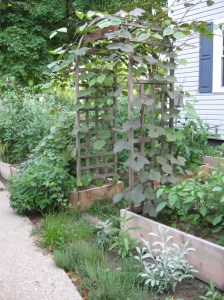
“Oh my! Look at these tomato plants! They are so big! Oh! Peppers? Are those peppers?”
“Yep.”
“Well this is interesting, different, but interesting. Oh and look here, squash? Very nice, very nice.”
“The leaves are a little too purple on this bean plant, and I am not getting any flowers on the pineapple sage, so I am thinking that they are lacking something nutritionally.”
“Oh I see. Like what? What are they lacking?”
“I haven’t tested the soil, but with these symptoms I am thinking Phosphorus.”
“Ahh, add bone meal.” The Stranger slowly nodded and had somewhat of a smile. What? Not everyone knows that bone meal is a source of phosphorus. I thought this stranger wasn’t much of a gardener?
The smile left the Stranger’s face. “What happened to the tree that was here? In the space behind the purple bean?”
Oh gee, the dreaded question. The Gardener looks at the ground, unable to make eye contact with the Stranger. “I had to cut it down.” There wasn’t anything wrong with the tree, but, it shaded almost all of the space. “This is the only area in the yard that can get any sun, and since I grow a lot of vegetables and herbs, I had to cut down the tree to create this sunlit patch.”
Nothing else was said. The heavy silence was awkward. The Stranger gazed over the space, as if looking for something else that wasn’t there, and then quickly changed the subject.
“Did you take out all of the carpet?”
“Yep. We finished the wood floors. They are beautiful.”
“I remember my mother always polishing the floors.” The Stranger’s voice quieted.
“Would you like to come in and see them? The house is a little messy, but you are more than welcome to come in.” Again, why did I invite this stranger into MY house. Especially since it is not as clean as it was when I moved in.
“I don’t want to impose. I pick up my cousin every Sunday for church,” pointing to the neighboring house, “I’ll stop by again. In the mean time, I will be watching what you do out here in the front.” As the Stranger began to walk back to the property line the Gardener noticed the gray Ford Taurus parked in the street in front of the neighboring house. I’ve seen that car before, driving slowly past the house. That’s who it is. Gray house, gray car.
“I’ll keep watching. I’m curious to see what you do.” The Stranger called out while waving.
Haunted by the visit, the Gardener continued to remove the rooted mass and decaying plant material. What will I do here? How could I have gone and killed everything that someone else had tried for so many years to grow? This is my house now, but why don’t I feel like this garden is mine? Formal landscape? What am I thinking? I am not formal.
With bare hands buried deep into the cool musty soil, the final steps are taken to remove all green life from the front landscape. I know now, I need to create an inviting landscape, one that welcomes any stranger to this home, filled with colorful flowers and native plants that should be growing in this garden for bees, butterflies and insects, and using methods that benefit the creatures living in the soil. The earth will never be owned by me, or anyone else. It is shared by us all, for a moment in our time. I will just tend the soil for now, garden how I feel is best, until I am gone and the next gardener comes to do what they want to do.

Tags: Fiction, Gardening


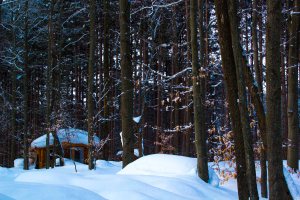




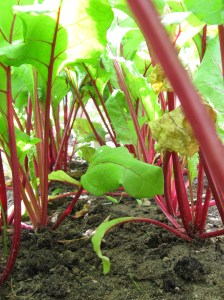




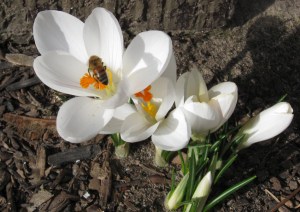
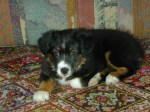






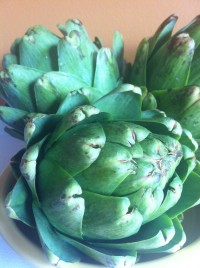



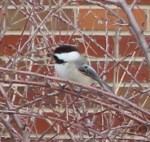 “Chick-a-dee dee dee. Chick-a-dee dee dee.” This is the sound I hear on the day I can sleep in. Outside my window, a repeating call. The mornings are lighter, and the noises are different…..My mind wanders as I fall in and out of consciousness…are these the sounds of migrating birds? Or maybe a mating call of a familiar bird that has changed its tune for the season….. I’m not a morning person, and it was nice to wake up early enough to listen to nature. “Whooo, who-who. Whoooo, who-who.” A dove sings it’s softly spoken song. Daylight savings time has started. I don’t understand why we do this. Someone please help me. I don’t know what the real time is. Just when I have no problem waking up in the morning, we have to move our clocks forward an hour. Now I will struggle again to wake up and rush to work on time. Why can’t we live by the sun? Like the plants and animals. They seem to do just fine without looking at the clock. What tells them to start growing or traveling to and fro? So my friend tells me “the good news is that our evenings will be lighter later.” It still doesn’t help with the struggles of waking up an hour earlier. Can I just lie in bed a little longer? The ground is frozen anyway. I attempt to pull the blanket up around my neck to get a few more minutes in, but the dog has positioned herself like a rock on the blanket at my feet preventing me from doing so……….Longer days ahead mean more time to work in the garden after I get home from my day job. I have attended enough garden education, garden shows, done enough garden reading and planning, it’s time to get outside and get my hands dirty. Oh geez, there’s still a foot of snow in some places, and if I see any soil, it is frozen solid. I would need a pick to break it apart. I need to make sure my low tunnels are ready so I can sow spinach and arugula seeds, and transplant the onions I sowed a few weeks ago…….I didn’t plant anything in the fall, maybe this year I will……. Once the snow melts and I can work the soil, in go the peas. I think that I will give the peas a little jump by planting them in a low tunnel to get them started…… Hmmm. Is my garden plan done? Maybe I should get out of bed and make sure. I need to look at my seed sowing calendar. When am I starting peppers? Is it this week? I think there is one more garden show coming up………..I think it’s raining. Almost spring, try to stay calm.
“Chick-a-dee dee dee. Chick-a-dee dee dee.” This is the sound I hear on the day I can sleep in. Outside my window, a repeating call. The mornings are lighter, and the noises are different…..My mind wanders as I fall in and out of consciousness…are these the sounds of migrating birds? Or maybe a mating call of a familiar bird that has changed its tune for the season….. I’m not a morning person, and it was nice to wake up early enough to listen to nature. “Whooo, who-who. Whoooo, who-who.” A dove sings it’s softly spoken song. Daylight savings time has started. I don’t understand why we do this. Someone please help me. I don’t know what the real time is. Just when I have no problem waking up in the morning, we have to move our clocks forward an hour. Now I will struggle again to wake up and rush to work on time. Why can’t we live by the sun? Like the plants and animals. They seem to do just fine without looking at the clock. What tells them to start growing or traveling to and fro? So my friend tells me “the good news is that our evenings will be lighter later.” It still doesn’t help with the struggles of waking up an hour earlier. Can I just lie in bed a little longer? The ground is frozen anyway. I attempt to pull the blanket up around my neck to get a few more minutes in, but the dog has positioned herself like a rock on the blanket at my feet preventing me from doing so……….Longer days ahead mean more time to work in the garden after I get home from my day job. I have attended enough garden education, garden shows, done enough garden reading and planning, it’s time to get outside and get my hands dirty. Oh geez, there’s still a foot of snow in some places, and if I see any soil, it is frozen solid. I would need a pick to break it apart. I need to make sure my low tunnels are ready so I can sow spinach and arugula seeds, and transplant the onions I sowed a few weeks ago…….I didn’t plant anything in the fall, maybe this year I will……. Once the snow melts and I can work the soil, in go the peas. I think that I will give the peas a little jump by planting them in a low tunnel to get them started…… Hmmm. Is my garden plan done? Maybe I should get out of bed and make sure. I need to look at my seed sowing calendar. When am I starting peppers? Is it this week? I think there is one more garden show coming up………..I think it’s raining. Almost spring, try to stay calm.